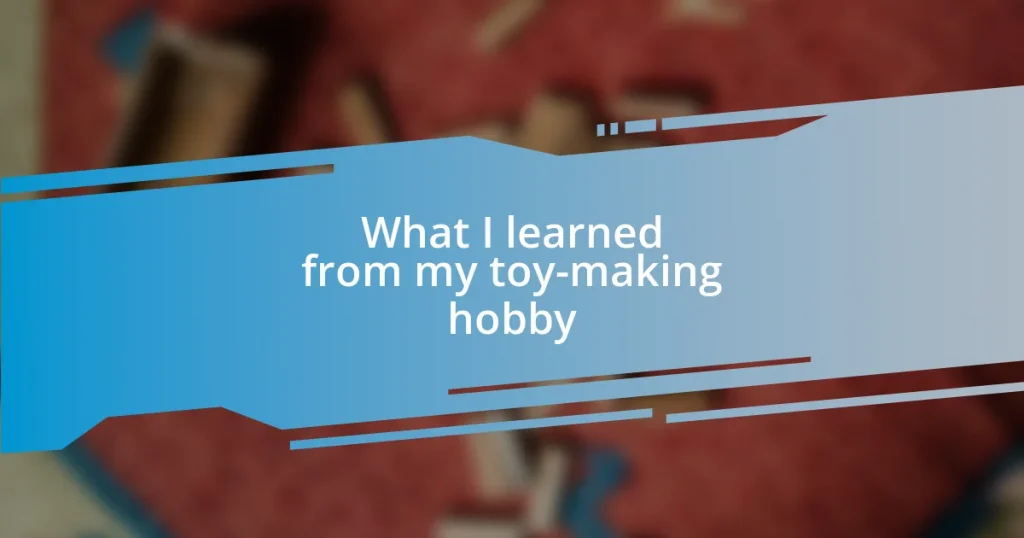Key takeaways:
- Sensory play toys engage a child’s senses and are vital for cognitive, emotional, and social development, fostering exploration and self-expression.
- Benefits include improved fine motor skills through activities like manipulating play dough, emotional regulation via calming activities like water beads, and enhanced social skills through collaborative play.
- Selecting the right sensory toys based on a child’s specific needs, age, and providing variety can significantly enrich their playtime experience and support emotional well-being.

Introduction to sensory play toys
Sensory play toys are fascinating tools designed to engage a child’s senses—sight, sound, touch, taste, and smell. I remember the first time I introduced sensory bins filled with different textures to my niece; her eyes lit up with curiosity, and I couldn’t help but smile at her excitement. It’s incredible how something so simple can spark a child’s imagination and stimulate their development.
These toys are more than just fun; they serve a vital role in cognitive and emotional growth. I often think about how my nephew, who struggled with focus, found calm and concentration while squeezing a stress ball. Can you imagine the joy of watching a child find their rhythm in play? It’s about facilitating moments where they can explore, learn, and express themselves freely.
Sensory play toys also cater to various developmental needs, making them accessible for all children. I’ve seen firsthand how these toys provide comfort and joy during challenging moments; they’ve helped families, including my own, create a safe space for exploration and connection. Isn’t it amazing how play can transcend mere enjoyment and become a bridge to understanding and emotional expression?

Benefits of sensory play
Sensory play offers a multitude of benefits, particularly when it comes to enhancing fine motor skills. I personally witnessed this when I gifted my little cousin a set of play dough tools. As she rolled and pinched the dough, I was amazed by how her hand-eye coordination improved, allowing her to craft intricate shapes. It’s incredible what a bit of creative play can do to strengthen those tiny muscles in a child’s hands!
The emotional benefits of sensory play are equally profound. I recall a time my friend’s son was feeling overwhelmed after a hectic day. They pulled out a bin filled with water beads, and within minutes, he was splashing, laughing, and visibly calmer. This firsthand experience reminded me that sensory activities can provide an outlet for emotions, helping kids to decompress and process their feelings.
Another noteworthy advantage of sensory play is its ability to foster social skills. I had the chance to observe a small group of kids interacting with a sand table at a playdate. They took turns, shared tools, and communicated their ideas, which created a delightful atmosphere of collaboration. I couldn’t help but feel a sense of pride seeing them navigate their social dynamics through the joy of play!
| Benefit | Example |
|---|---|
| Fine Motor Skills | Manipulating play dough enhances hand-eye coordination. |
| Emotional Regulation | Water beads help children calm down and process feelings. |
| Social Skills | Kids share and collaborate while playing with sensory bins. |

Types of sensory play toys
Sensory play toys come in various forms, each designed to engage different senses and aid in development. I’ve seen how unique textures like sand and gel can ignite a child’s curiosity and create moments of wonder. One time, I brought home a box of textured balls for my nephew, and watching him bounce them with delight while discovering the different feels was unforgettable; it was a simple joy, yet it sparked so much excitement in him.
Here’s a quick breakdown of types of sensory play toys you might consider:
- Textured Balls: Great for tactile exploration and motor skills.
- Play Dough: Offers endless opportunities for creativity while enhancing fine motor skills.
- Sensory Bins: Filled with a variety of materials like rice or beans, these promote exploration and imaginative play.
- Fidget Toys: Useful for focusing attention and providing calming tactile input.
- Water Beads: Perfect for visual and tactile stimulation; they change in size and texture when wet.
- Musical Instruments: Engaging sounds help develop auditory skills and encourage rhythm.
By incorporating these toys into playtime, I think we can create enriching experiences that children will cherish and learn from.

Selecting the right sensory toys
Selecting the right sensory toys can feel overwhelming given the vast array available, but I believe focusing on your child’s specific needs is key. For instance, when my niece was struggling with concentration during homework, I introduced her to a fidget spinner. It became a game-changer for her, allowing her to channel restlessness into something productive. Have you ever noticed how a simple tool can completely shift a child’s focus?
When I look for sensory toys, I always consider the age and developmental stage of the child. With my nephew, I discovered that soft, squishy toys like stress balls were perfect for him, as they not only engaged his senses but also helped him manage anxiety in social settings. It often surprises me how sensory play can foster emotional well-being, especially during challenging moments. Have you thought about how some toys can serve dual purposes, both for fun and comfort?
Lastly, I find that variety is crucial. By rotating the sensory toys we use, like introducing new textures or challenges, we keep playtime fresh and exciting. I remember the joy on my friend’s daughter’s face when I brought over a box of colorful kinetic sand; she was fascinated and spent hours crafting and reshaping. Exploring new sensory experiences can ignite creativity and keep children eager to learn. What if the next toy you select sparks a whole new interest for your little one?















